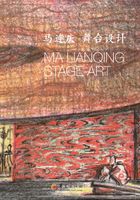
Preface II
Blooming Spring
Cai Tiliang (President of CASA)
It is neither too long nor too short since I have acquainted with Mr. Ma Lianqing. I gradually understand and appreciate him through watching his creative productions. I have watched a number of performances designed by him now sitting as an audience in the auditorium, now appearing as a judge. And he and his works have never failed to fascinate me in those formal occasions.
However, to be frank, I used to appreciate his works at a relatively emotional and instinctive level and never tried to analyze them from a comprehensively rational perspective. Until recently, when I was asked to write the preface for his upcoming publication of stage art work collection which did surprise me, I realized that it’s time to re-think Ma’s stage art designs, on the aspects of his creative ideas, his artistic styles and his inheritance patterns in a rational and all-round manner.
Lianqing’s stage art creation covers a broad range. He never sticks to one form and involves himself in genres including the mainstream of western operas and ballet, as well as the traditional Chinese operas, child plays and popular evening shows. For most designers, they were often not given the opportunity of choosing the subjects and genres as “freely” as they could, instead, they just accept “passively” whatever they are given to. In that sense, the designers should be of great adaptability in creating to handle the complex and ever-changing subjects and genres. Lianqing seems to be not afraid of challenges. With his open mind and rich life experiences (two aspects which I think is the basics of a good artist) , he shows his talents in varied creative works which makes him stand out. It is unnecessary to go into details here,the splendor of his talented designs touching different genres and subjects, reflecting his insistence on art, being shown in different stages can all be found in his work collection.
One of the flashlights in Lianqing’s stage art designs is his inheritance of the traditional culture. China boasts its abundant cultural and artistic heritage, while Lianqing shows great responsibility of an artist through creating the works in an open mind and inheriting and developing the essence of traditional culture. The essence of the traditional art are wisely included in his stage art designs, being reflected through different stage patterns and models. Whether in his designs of traditional operas or modern operas, Lianqing prefers using the pattern of “One table with two chairs” which can successfully, flexibly match the nature of the performance. He finds perfect balance between the traditional aesthetic and the modern stage pattern in his productions including different genres ranging from Pingju Opera (a local opera of north or northeast China), tea-picking opera to dance drama. The stage art design job is also very conducive to the whole performance at a comprehensive level.
China National Opera House, where Lianqing works as the chief stage art designer,can be regarded as the weather vane of the opera stage art of modern China. In that sense, the stage art creation of CNOH including its style, value orientation and aesthetic significance are given great attention and accordingly strict examination.Naturally it has faced and will face more challenges, di fficulties and obstacles. And the development of the modern Chinese theatric art fares likewise. I am confident in saying that the stage art designs of operas included in this work collection can be regarded as the epitome of the modern opera stage art designs in China. The stage art design of the opera is often much more complicated and restricted both financially and functionally compared with that of the other genres. The productions including the inside-and-outside staged “Turandot,” the all-dimensional designed “Die Fledermaus” and the painting-like presented “Tannhäuser” and “The Dream of the Mountains” all prove his maturity in stage art design. By the way, I’d like to mention that there existed some misleading opinions about the stage art designs. Some people believed “the grander, the better” which is not always so true in practice.Conversely, to design to fit the scale and actual circumstances has a greater chance of success.
These are all my thoughts on Mr. Ma and his works. I may have left many important points and I hope my words can serve as a modest spur to more attention to his works. In the end, I’d like congratulate to Lianqing for the successful publication of his work collection, which is the gospel to the author, the publisher and the readers.